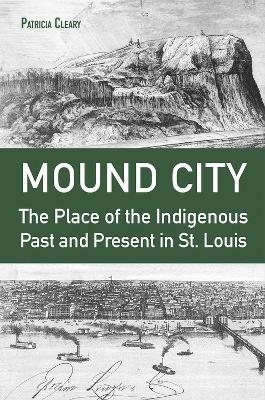
Mound City
The Place of the Indigenous Past and Present in St. Louis
Seiten
2024
University of Missouri Press (Verlag)
978-0-8262-2304-3 (ISBN)
University of Missouri Press (Verlag)
978-0-8262-2304-3 (ISBN)
Drawing on a wide range of sources - including maps, daguerreotypes, real estate deeds, court records, travelers’ accounts, scientific treatises, government records, and personal correspondence - Patricia Cleary explores the layers of the Indigenous history of St. Louis.
Nearly one thousand years ago, Native Americans built a satellite suburb of ancient America’s great metropolis, Cahokia, on the site that later became St. Louis. At its height, as many as 30,000 people lived in and around Cahokia. While the eastern mounds of Cahokia survive today (designated as a state historic site and UNESCO world heritage site), the monumental earthworks that stood on the western shore of the Mississippi were razed by railroad workers in the 1800s. But before and after they fell, the mounds held an important place in St. Louis history, earning it the nickname “Mound City.” For decades, the city had an Indigenous reputation. Tourists came to marvel at the mounds and to see tribal delegations in town for trade and diplomacy. As the city grew, residents repurposed the mounds--for a reservoir, a restaurant, and railroad landfill--in the process destroying cultural artifacts and sacred burials. Despite evidence to the contrary, some white Americans declared the mounds natural features, not built ones, and cheered their leveling. Others espoused far-fetched theories about a lost race of Mound Builders killed by the ancestors of contemporary Indigenous peoples. Ignoring Indigenous people’s connections to the mounds, white Americans positioned themselves as the inheritors to the ancient traditions and asserted that modern Native peoples were destined to vanish. These are, of course, the same such views that served as justification for national policy that effected Indian Removal and, to a great extent, the exclusion of Indigenous people from politics and society. Claiming Indigenous history as their own, white St. Louisans would go on to play the roles of Mound Builders in a city-sponsored history pageant, while a women’s heritage group commemorated the mounds as local history.
Drawing on a wide range of sources--including maps, daguerreotypes, real estate deeds, court records, travelers’ accounts, scientific treatises, government records, and personal correspondence--Patricia Cleary explores the layers of the Indigenous history of St. Louis. Along with the first in-depth overview of the life, death, and afterlife of the mounds, Mound City offers readers compelling evidence of the place of Indigenous peoples in the city’s growth, the evolution of its landscape, and the episodes and monuments that shaped its civic culture.
Nearly one thousand years ago, Native Americans built a satellite suburb of ancient America’s great metropolis, Cahokia, on the site that later became St. Louis. At its height, as many as 30,000 people lived in and around Cahokia. While the eastern mounds of Cahokia survive today (designated as a state historic site and UNESCO world heritage site), the monumental earthworks that stood on the western shore of the Mississippi were razed by railroad workers in the 1800s. But before and after they fell, the mounds held an important place in St. Louis history, earning it the nickname “Mound City.” For decades, the city had an Indigenous reputation. Tourists came to marvel at the mounds and to see tribal delegations in town for trade and diplomacy. As the city grew, residents repurposed the mounds--for a reservoir, a restaurant, and railroad landfill--in the process destroying cultural artifacts and sacred burials. Despite evidence to the contrary, some white Americans declared the mounds natural features, not built ones, and cheered their leveling. Others espoused far-fetched theories about a lost race of Mound Builders killed by the ancestors of contemporary Indigenous peoples. Ignoring Indigenous people’s connections to the mounds, white Americans positioned themselves as the inheritors to the ancient traditions and asserted that modern Native peoples were destined to vanish. These are, of course, the same such views that served as justification for national policy that effected Indian Removal and, to a great extent, the exclusion of Indigenous people from politics and society. Claiming Indigenous history as their own, white St. Louisans would go on to play the roles of Mound Builders in a city-sponsored history pageant, while a women’s heritage group commemorated the mounds as local history.
Drawing on a wide range of sources--including maps, daguerreotypes, real estate deeds, court records, travelers’ accounts, scientific treatises, government records, and personal correspondence--Patricia Cleary explores the layers of the Indigenous history of St. Louis. Along with the first in-depth overview of the life, death, and afterlife of the mounds, Mound City offers readers compelling evidence of the place of Indigenous peoples in the city’s growth, the evolution of its landscape, and the episodes and monuments that shaped its civic culture.
Patricia Cleary is Professor of History at California State University, Long Beach, where she teaches early American history. She is the author of two other books: The World, the Flesh, and the Devil: A History of Colonial St. Louis and Elizabeth Murray: A Woman’s Pursuit of Independence in Eighteenth-Century America.
| Erscheinungsdatum | 04.06.2024 |
|---|---|
| Zusatzinfo | 83 colour and b&w illustrations |
| Verlagsort | Missouri |
| Sprache | englisch |
| Maße | 152 x 229 mm |
| Gewicht | 1021 g |
| Themenwelt | Geisteswissenschaften ► Geschichte ► Allgemeine Geschichte |
| Geisteswissenschaften ► Geschichte ► Regional- / Ländergeschichte | |
| Geschichte ► Teilgebiete der Geschichte ► Kulturgeschichte | |
| Sozialwissenschaften ► Ethnologie | |
| Sozialwissenschaften ► Soziologie | |
| ISBN-10 | 0-8262-2304-4 / 0826223044 |
| ISBN-13 | 978-0-8262-2304-3 / 9780826223043 |
| Zustand | Neuware |
| Haben Sie eine Frage zum Produkt? |
Mehr entdecken
aus dem Bereich
aus dem Bereich
der stille Abschied vom bäuerlichen Leben in Deutschland
Buch | Hardcover (2023)
C.H.Beck (Verlag)
23,00 €
vom Mittelalter bis zur Gegenwart
Buch | Softcover (2024)
C.H.Beck (Verlag)
12,00 €


